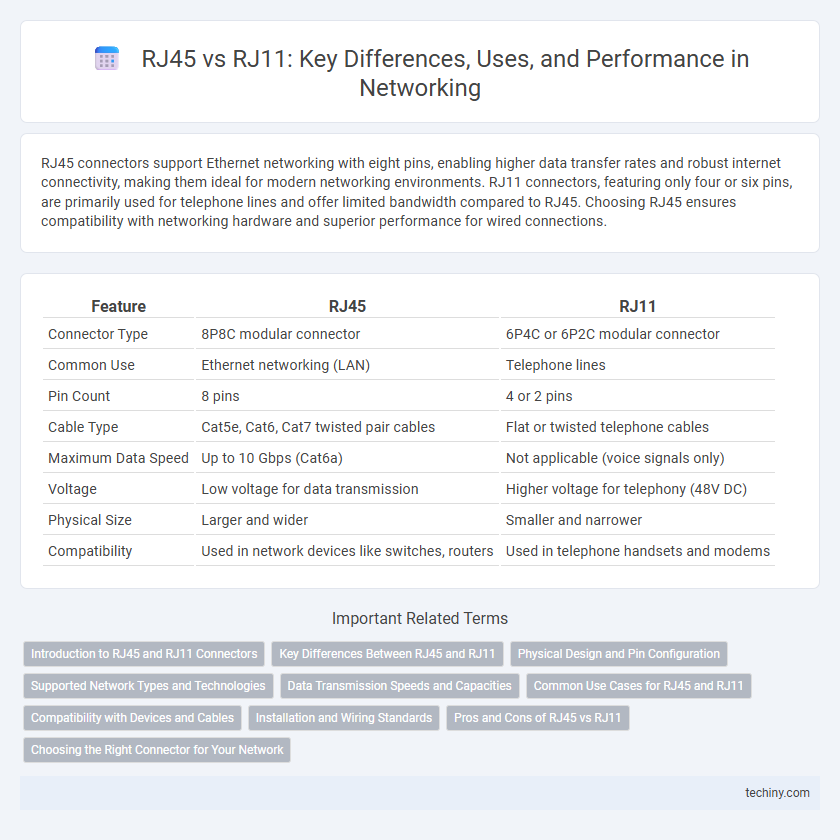RJ45 connectors support Ethernet networking with eight pins, enabling higher data transfer rates and robust internet connectivity, making them ideal for modern networking environments. RJ11 connectors, featuring only four or six pins, are primarily used for telephone lines and offer limited bandwidth compared to RJ45. Choosing RJ45 ensures compatibility with networking hardware and superior performance for wired connections.
Table of Comparison
| Feature | RJ45 | RJ11 |
|---|---|---|
| Connector Type | 8P8C modular connector | 6P4C or 6P2C modular connector |
| Common Use | Ethernet networking (LAN) | Telephone lines |
| Pin Count | 8 pins | 4 or 2 pins |
| Cable Type | Cat5e, Cat6, Cat7 twisted pair cables | Flat or twisted telephone cables |
| Maximum Data Speed | Up to 10 Gbps (Cat6a) | Not applicable (voice signals only) |
| Voltage | Low voltage for data transmission | Higher voltage for telephony (48V DC) |
| Physical Size | Larger and wider | Smaller and narrower |
| Compatibility | Used in network devices like switches, routers | Used in telephone handsets and modems |
Introduction to RJ45 and RJ11 Connectors
RJ45 and RJ11 connectors are essential components in networking and telecommunications, with RJ45 primarily used for Ethernet cables in LAN connections, supporting up to 8 wires for high-speed data transmission. RJ11 connectors, smaller with 4 or 6 wires, are commonly used for telephone lines and lower bandwidth applications. Understanding the distinct pin configurations and compatibility of RJ45 and RJ11 connectors is crucial for proper network infrastructure setup and troubleshooting.
Key Differences Between RJ45 and RJ11
RJ45 connectors are primarily used for Ethernet networking, featuring eight pins to support higher data transfer rates and multiple wires, whereas RJ11 connectors are designed for telephone lines with only four or six pins. RJ45 cables enable fast, reliable network connections suitable for data transmission, while RJ11 cables facilitate voice communication and lower-speed data transfers. The physical size and pin configuration distinctly separate RJ45 and RJ11, making RJ45 compatible with modern networking standards like Cat5e and Cat6 cables.
Physical Design and Pin Configuration
RJ45 connectors feature an 8-position, 8-contact (8P8C) design used primarily for Ethernet networking, supporting data transmission over twisted pair cables. RJ11 connectors, smaller with a 6-position, 2 or 4-contact (6P2C or 6P4C) configuration, are typically used for telephone wiring and offer fewer conductors for limited signaling. The physical size difference and pin arrangement directly impact their compatibility and application in networking environments.
Supported Network Types and Technologies
RJ45 connectors support Ethernet networks, including 10BASE-T, 100BASE-TX, and 1000BASE-T standards, enabling high-speed LAN connectivity for modern data communication. RJ11 connectors are primarily used for telephone line connections and support analog voice and DSL broadband services but are not suitable for Ethernet networking. The 8-pin RJ45 provides greater data transmission capability compared to the 6-pin RJ11, making RJ45 the standard for network interfaces and RJ11 limited to telephony applications.
Data Transmission Speeds and Capacities
RJ45 connectors support higher data transmission speeds up to 10 Gbps, making them ideal for Ethernet networks, whereas RJ11 connectors typically handle lower speeds suitable for telephone lines and DSL connections, generally maxing out around 56 Kbps. RJ45 cables utilize 8 pins and pairs of twisted wires to enable faster and more reliable data transfer with greater bandwidth capacity. In contrast, RJ11 connectors have only 4 or 6 pins, restricting their ability to carry high-speed data and larger volumes of network traffic.
Common Use Cases for RJ45 and RJ11
RJ45 connectors are primarily used for Ethernet networking, supporting data transfer rates up to 10 Gbps in local area networks (LANs) and are standard in computer networking, routers, and switches. RJ11 connectors are typically used for telephone lines, enabling voice communication and DSL internet connections with lower data speeds compared to RJ45. The distinct pin configurations--eight pins for RJ45 and six or four pins for RJ11--reflect their optimized designs for data versus voice transmission applications.
Compatibility with Devices and Cables
RJ45 connectors are widely compatible with Ethernet cables and networking devices such as routers, switches, and computers, supporting standards like Cat5e, Cat6, and Cat7. RJ11 connectors are primarily designed for telephone lines and are compatible with telephone cables and devices like landline phones and modems, but cannot be used interchangeably with RJ45 ports or cables. The physical differences in pin configuration and size prevent RJ11 connectors from fitting into RJ45 jacks, ensuring device and cable compatibility is maintained within each category.
Installation and Wiring Standards
RJ45 connectors are primarily used for Ethernet networking with 8 pins supporting Category 5e, 6, or higher cables, following the T568A or T568B wiring standards for proper installation and signal integrity. RJ11 connectors, designed for telephone lines, have 4 or 6 pins and use simpler wiring schemes that are not suitable for high-speed data transmission. Proper installation of RJ45 requires adherence to color-coded wiring sequences and secure crimping to ensure reliable network connectivity and minimize crosstalk.
Pros and Cons of RJ45 vs RJ11
RJ45 connectors support eight wires, enabling faster data transmission and better performance for Ethernet networks compared to the RJ11's four-wire design primarily used in telephone lines. RJ45 offers higher bandwidth and compatibility with modern networking equipment, while RJ11 is more compact and suitable for voice communication but limited in speed and data capacity. However, RJ45 connectors are larger and can be more expensive, whereas RJ11's simplicity and cost-effectiveness make it ideal for legacy telephony applications.
Choosing the Right Connector for Your Network
Selecting the right connector for your network depends heavily on the intended application and device compatibility; RJ45 connectors, designed for Ethernet cables, support high-speed data transmission up to 10 Gbps and are essential for modern LAN setups. RJ11 connectors, typically used for telephone lines, accommodate fewer wires, limiting their use to voice and low-speed data communications. Prioritizing RJ45 ensures optimal network performance and future-proofing, while RJ11 suits legacy telephone systems and basic DSL connections.
RJ45 vs RJ11 Infographic

 techiny.com
techiny.com